-
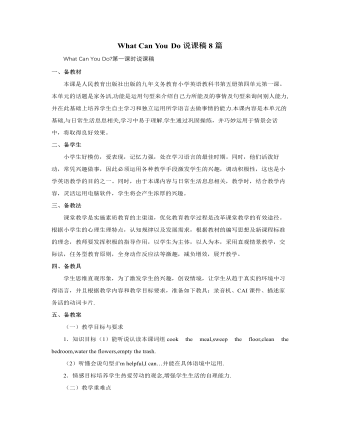
人教版新课标PEP小学英语五年级上册What Can You Do说课稿8篇
目的是让学生更深入理解Just do it的意思,能在一定情景中运用。接下来出示一些山羊妈妈的动物朋友引出课文内容。让学生先观看课文的视频,这样更生动些,也许也能更引起学生的兴趣些,因为这是一堂相对比较枯燥的读写课,有了视频观看可能更生动和有趣些。通过完成课文填空和课后回答问题,让学生既练习到写,又练习到对课文的理解,之后再让学生演一演深入课文的朗读。在最后一环节再让学生完成一个new dialogue的填空运用。这样使整堂课更完整些,学生再一次运用所学知识得到拓展。What Can You Do? PaRT B 第二课时说课稿一、教材分析1.教学内容本课主要学习有关家务劳动的表述,主要句型有:Can you ……?Yes ,I can No, I can’t .本课时的大部分动词词组在四年级上下册中都已出现过。如:Water the flowers ,sweep the floor ,set the table.2.教学目标。(1)语言技能与知识目标通过本课的学习,能够询问别人能做什么家务。如:Can you set the table ?(2)运用能力目标会用Can you…?语句询问并作出肯定或否定回答。
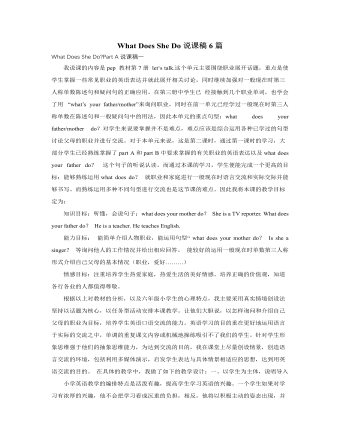
人教版新课标PEP小学英语六年级上册What Does She Do说课稿6篇
My Home本身就是一个与生活有着紧密联系的话题。我从这一点出发,紧紧围绕生活来开展教学。在Write and say这部分内容的教授中,我通过介绍我自己房间里的家具,如:Th is is my room, you can see a window、a door、a desk、a chair、a bed, Oh, It is a nice room . I like it,引出句型What can you see in my room ?引导学生说:I can see a window、a door、a desk、a chair、a bed, Oh, It is a nice room . I like it,然后安排同桌间拿出自己准备的房间图片,根据房间图片,相互之间询问。要求学生简单描述自己的房间,结合学过的语言描述房间内家具陈设的名称、特征等。学生看着自己亲手绘制的房间图片,亲切感、生活的真实感都一股脑儿地涌上心头。此时他们用学习的语言进行交流的愿望也就特别强烈。 最后、渗透情感教育 让学生通过谈论自己的房间,培养学生对家的热爱之情;我在这样的教学中渗透了学生热爱家庭的情感教育:因为,家是我们每个人永远的港湾,我们要爱家,爱护家里的每一样家具。
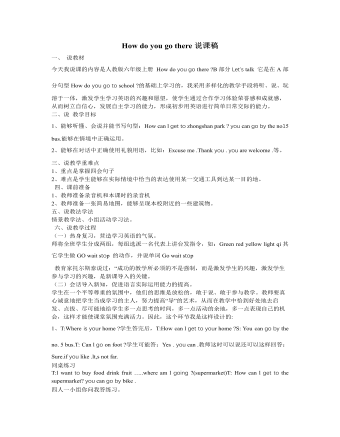
人教版新课标PEP小学英语六年级上册How do you go there说课稿
一、 说教材今天我说课的内容是人教版六年级上册 How do you go there ?B部分Let’s talk 它是在A部分句型How do you go to school ?的基础上学习的,我采用多样化的教学手段将听、说、玩溶于一体,激发学生学习英语的兴趣和愿望,使学生通过合作学习体验荣誉感和成就感,从而树立自信心,发展自主学习的能力,形成初步用英语进行简单日常交际的能力。二、说 教学目标1、能够听懂、会说并能书写句型:How can l get to zhongshan park ? you can go by the no15 bus.能够在情境中正确运用。2、能够在对话中正确使用礼貌用语,比如:Excuse me .Thank you . you are welcome .等。三、说教学重难点 1、重点是掌握四会句子2、难点是学生能够在实际情境中恰当的表达使用某一交通工具到达某一目的地。 四、课前准备 1、教师准备录音机和本课时的录音机2、教师准备一张简易地图,能够呈现本校附近的一些建筑物。
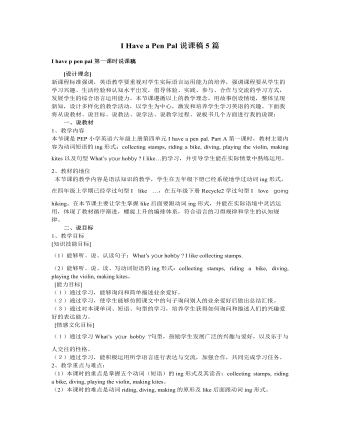
人教版新课标PEP小学英语六年级上册I Have a Pen Pal说课稿5篇
一、说教学思想我在本课教学设计中坚持以人文科技教育为中心,以学生为主体;以兴趣为支点、以交流为目的、以活动任务为途径的教学原则。通过最新的计算机多媒体等教学手段创造贴近生活的教学情境,并在课堂上大量地采用互动式教学模式(包括人机互动),使学生自然进入英语世界;在教学过程中,综合运用情景教学、任务型教学、交际教学、整体语言教学等手段,全面培养学生的听、说、读、写等语言综合运用能力。在课内、课外全面利用网络技术,如在线英语学习、博客(Blog)、魔灯(Moodle)、QQ群、论坛(BBS)等手段,做到英语与信息技术的完美整合。二、说教材与教材处理本课采用的教材是是人教版小学英语(PEP)六年级上册,内容为学生学完I Have a Pen Pal后的一节综合实践活动(复习)课。本单元教学重点为E-mail和英语书信的写法。通过该单元的学习,学生基本了解一些英语书信书写的方法。但是学生还没有利用计算机网络去写英文E-mail(包括写E-mail内容和写E-mail地址。)
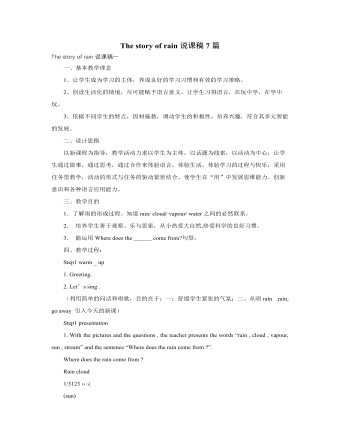
人教版新课标PEP小学英语六年级上册The story of rain说课稿7篇
4,在向学生提出了“ the water cycle”后,为了学生能够形象地解释,我马上播放flash “the water cycle”,5,通过观看flash “the water cycle”,学生已经能够理解水循环的意思,所以在理解的基础上,我出现了今天的chant,利用Chant的目的:1、记忆单词;2、熟悉新句型;3、使课堂更生动、活泼,让学生学得轻松。6,最后,播放了一个“一滴水”flash ,把本课的主题升华,让学生在一堂课中能够有所学有所悟。Water is useful(有用的). Let’s love it and protect(保护) it. Step 4 Homework在有限的时间里,通过练习作业本上的几个题目,来看看学生对本课的学习掌握了多少,同时也反馈给老师一些信息,看看本课哪些地方需要下一课时补充巩固一下。整堂课下来,自身受益匪浅,当然也发现了很多需要改进的地方,作为一个新教师,教学经验不足,课堂应变能力不强,教学用语生疏等等,希望在这里可能得到各位老师的指点和教导。
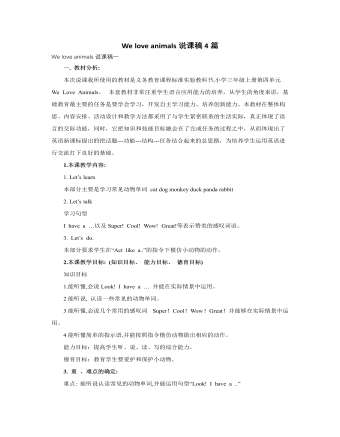
人教版新课标PEP小学英语三年级上册We love animals说课稿4篇
能力目标:培养学生听,做,说,读,写的能力,增进身体各部分的协调能力,语言表达能力。情感目标:让学生通过运用语言来完成学习任务,感受成功,从而引发和培养学生学习英语的内在动机,最终使他们形成英语学习的积极态度。同时培养学生要爱护动物。2. 教学重难点本课的教学重点是让学生能听、说、认读六个有关动物的词汇。教学难点是学生能将这六个有关动物的词汇运用到简单的英语句子中表达,突破重点和难点的关键是结合低年级学生喜欢游戏的特点,通过玩游戏,使单调的知识溶进生动的活动之中,让学生在听,做,动的过程中,掌握知识,并灵活地运用。三.说教法1.教法设计为了顺利完成以上教学目标,更好地突出重点,突破难点,按照学生的认识规律,我采用了讲读、直观演示、愉快教学相结合的方法,层层递进,激发学生的学习兴趣,充分调动他们学习的积极性,保持他们强烈的好奇心和旺盛的求知欲,进而促使他们由兴趣发展到产生要学好它的志趣。
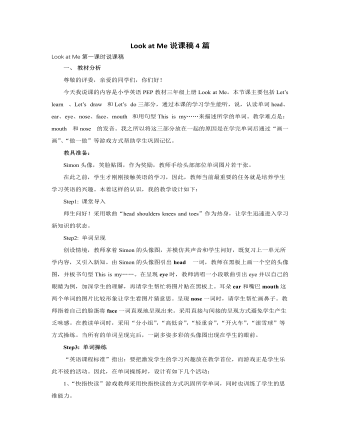
人教版新课标PEP小学英语三年级上册Look at Me说课稿4篇
5. 文化目标:本单元的文化知识是西方的万圣节(10月31日),万圣节是西方孩子们最喜欢的节日之一。他们身穿不同的戏装,戴上千奇百怪的面具,在街区走来走去。不少孩子手中还提着一盏“杰克灯”(Jack-o’-lantern)/南瓜灯,这种灯的做法是先把南瓜挖空,在南瓜上挖出眼睛、嘴和鼻子,贴上蓝色纸,制成南瓜灯,当中点上一支小蜡烛,放出幽灵似的蓝白光。孩子们常常从一家走到另一家,在人家门前高喊:“你想挨捉弄,还是款待我们?”(Trick or treat!)如果主人不给糖果或零钱,这些孩子就会捉弄他(她)。他们有时在门把手上涂上肥皂,有时把人家的猫涂上颜色。这些恶作剧常令大人啼笑皆非。当然,大多数人家都非常乐意款待这些天真的小客人。在晚上,人们常举行晚会,孩子和大人都身穿不同服装。万圣节人们常常做一些传统的游戏和活动,像:试图摘悬挂的苹果,算命,听有关鬼的故事。学校也经常举行晚会或化装游行。
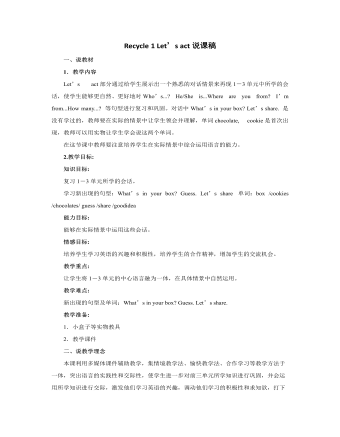
人教版新课标PEP小学英语三年级上册Recycle 1 Let’s act说课稿
小学生学习的主动性,大多取决于兴趣,他们充满好奇,对显而易见的实物和直观信息敏感性强、接受快。借助多媒体计算机CAI辅助教学,把所学内容更加直观地表现出来。4.游戏式复习热身,体现课堂教学开放性利用做游戏的形式进行旧知识的复习,既消除了上课初老师和学生之间的陌生感,又激发了学生学习兴趣,同时又对前面所学内容进行了巩固。5.综合运用“愉快教学”、“情境教学”、“合作学习”等多种教学方法,降低学习难度,活跃课堂气氛。6.展开活动式教学,设计各种形式为教学服务的活动,让学生在学中乐,在乐中学,不断强化知识的巩固记忆。7.设置评比台,及时评价小组及个人表现,鼓励学生积极参与学习活动。四、说教学流程1.拍手游戏热身2.师生问好,交流,对第一页内容复习3.引入第二页内容,学习新单词、句型4.趣味操练
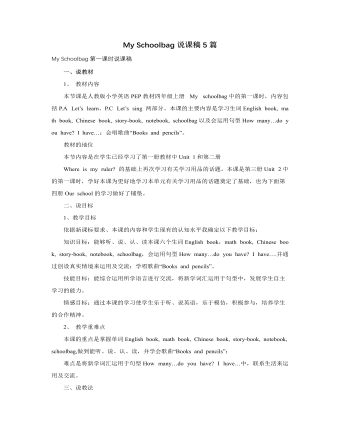
人教版新课标PEP小学英语四年级上册My Schoolbag说课稿5篇
(1)Sing a song.由于老师是借班上课,师生间难免会由于陌生而产生距离,所以选一首大家都熟悉的歌曲可以把师生间的距离拉近。(2)通过听指令做动作(如:point to the window , point to the door ….)等复习第一单元的知识,同时为进入本单元的schoolbag作铺垫。第二步:. Presentation 激情引趣,学习新知(1)由point to the bag 导入课题(板课题) 并引导学生说。(2)多媒体课件呈现所学新单词。学习单词按易到难,由浅入深原则逐一学习。先从大家熟悉的English book入手,然后到Chinese book, math book, notebook ,。由于story-book比较难发音,因此安排在最后。(3)通过图片、单词卡片、课本让学生反复指认这些单词。(4)Guessing game .让学生快速抢猜单词。(5)教学句型:How many …do you have? I have….通过学生与老师 ,老师与老师之间的对话来加强学习,在同学们熟悉单词后,引导他们加入How many …do you have? I have….进行操练。
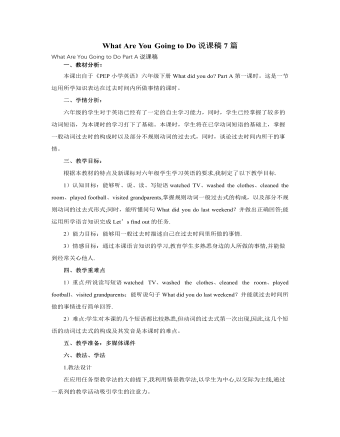
人教版新课标PEP小学英语六年级上册What Are You Going to Do说课稿7篇
四.说教学方法 “任务型”教学方法. 在本课的教学中,学生要完成购买书籍这样一个任务.这给学生创造了一个真实的语境去运用所学的句子进行交际.教师安排了4个活动:单词操练游戏、小组竞赛、小组活动和购物. 五.说教学准备 (一)教师准备:1.单词卡片。2.课件。3.各种书籍。 (二)学生准备:各种书籍. 六.说学习策略 在本节课上,学生可以通过多种方法来学习并记忆单词,如跟读、拼读、分音节、读看实物说单词、听单词拿实物等等.小组竞赛能激发学生的学习热情,鼓励学生表现自己. 七.说教学过程 一.复习和热身(Warm up) 1.唱英语歌曲. 2.朗读“口语天天练”的句子. 3.日常对话. 二.呈现新课(Presentation) 1.播放课件,呈现单词.学生跟读单词. 2.学习新单词. (1)教师带读单词,学生跟读. (2)拼读单词. (3)学生熟读单词.
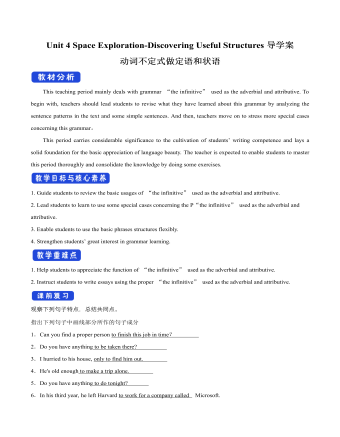
新人教版高中英语必修3Unit 4 Space Exploration-Discovering Useful Structures导学案
【点津】 1.不定式的复合结构作目的状语 ,当不定式或不定式短语有自己的执行者时,要用不定式的复合结构?即在不定式或不定式短语之前加 for +名词或宾格代词?作状语。He opened the door for the children to come in. 他开门让孩子们进来。目的状语从句与不定式的转换 英语中的目的状语从句,还可以变为不定式或不定式短语作状语,从而使句子在结构上得以简化。可分为两种情况: 1?当目的状语从句中的主语与主句中的主语相同时,可以直接简化为不定式或不定式短语作状语。We'll start early in order that/so that we may arrive in time. →We'll start early in order to/so as to arrive in time. 2?当目的状语从句中的主语与主句中的主语不相同时,要用动词不定式的复合结构作状语。I came early in order that you might read my report before the meeting. →I came early in order for you to read my report before the meeting.

新人教版高中英语必修3Unit 1 Festivals and Celebrations教学设计二
1. Ss look at the picture and scan the passage to understand the main idea while teacher is giving the following questions to inspire Ss to think.*Where are those people?*What are they doing?*Why are they so excited?2. Ss complete the passage with the appropriate -ing form. Then discuss and check the answers with class.Answers: boring, interesting, taking, exciting, amazing3. The teacher raises questions for the students to discuss and encourages them to express their opinions.*Do you like La Tomatina? Why or why not?4. Each group representative reports the discussion result, the teacher gives feedback and the evaluation.Step 6 PracticeActivity 41. Ss complete the Ex 2 in Using structures.2. Check the answers after finishing the exercises.①The dragon boat races are the most exciting part of the Dragon Boat Festival.② The children were excited to go Easter egg hunting.③What an amazing performance! This is the best music festival I have ever been to.④We were amazed by her funny-looking hat.⑤His inspiring speech at the conference won the admiration/ favour of the audience.⑥This is a challenging game to test your memory and observation capabilities. 3. T asks Ss to finish Ex 3 and 4 in Using structures by themselves, then check the answers with class.Step 6 Homework1. Understand and master the functions and usage of the -ing form;2. Finish the other exercises in Using structures.1、通过本节内容学习,学生是否理解和掌握动词-ing形式作定语和表语的功能和意义;2、通过本节内容学习,学生能否在理解文段内容的基础上,根据上下文语境和表达逻辑,能正确运用动词-ing形式描述节日庆典。3、通过本节内容学习,学生是否归纳和积累用于表达情绪的相关词汇。

新人教版高中英语必修3Unit 1 Festivals and Celebrations教学设计一
本板块的活动主题是“谈论节日活动”(Talk about festival activities),主要是从贴近学生日常生活的角度来切入“节日”主题。学生会听到发生在三个国家不同节日场景下的简短对话,对话中的人们正在参与或将要亲历不同的庆祝活动。随着全球化的进程加速,国际交流日益频繁,无论是国人走出国门还是外国友人访问中国,都已成为司空见惯的事情。因此,该板块所选取的三个典型节日场景都是属于跨文化交际语境,不仅每组对话中的人物来自不同的文化背景,对话者的身份和关系也不尽相同。1. Master the new words related to holiday: the lantern, Carnival, costume, dress(sb)up, march, congratulation, congratulate, riddle, ceremony, samba, make - up, after all. 2. To understand the origin of major world festivals and the activities held to celebrate them and the significance of these activities;3. Improve listening comprehension and oral expression of the topic by listening and talking about traditional festivals around the world;4. Improve my understanding of the topic by watching pictures and videos about different traditional festivals around the world;5. Review the common assimilation phenomenon in English phonetics, can distinguish the assimilated phonemes in the natural language flow, and consciously use the assimilation skill in oral expression. Importance:1. Guide students to pay attention to the attitude of the speaker in the process of listening, and identify the relationship between the characters;2. Inspire students to use topic words to describe the festival activities based on their background knowledge. Difficulties:In the process of listening to the correct understanding of the speaker's attitude, accurately identify the relationship between the characters.

新人教版高中英语必修3Unit 2 Morals and Virtues教学设计二
Activity 41. Students complete the task of activity 4, then teachers and students check the answers. 2. The teacher organized the students to work together and asked them to use the tables and mind maps sorted out before to retold the important choices in Lin Qiaozhi's life and their resultsStep 5 Language points1. The teacher asks the students to read the text carefully, find out the core words and long and difficult sentences in the text and draw lines, understand the use of vocabulary, and analyze the structure of long and difficult sentences. 2. The teacher explains and summarizes the usage of core vocabulary and asks the students to take notes. 3. The teacher analyzes and explains the long and difficult sentences that the students don't understand, so that the students can understand them better. Step 6 Homework1. Read the text again, in-depth understanding of the text; 2. Master the use of core vocabulary and understand the long and difficult sentences. 3. Complete relevant exercises in the guide plan. 1、通过本节内容学习,学生是否理解和掌握阅读文本中的新词汇的意义与用法;2、通过本节内容学习,学生能否结合文本特点总结林巧稚的人生原则和人格品质特征;3、通过本节内容学习,学生能否针对人生抉择发表自己的看法;能否全面地、客观地、理性地看待问题,进而对道德和人性有更加深入的思考和理解。

新人教版高中英语必修3Unit 2 Morals and Virtues教学设计三
The joke set her crying.这个玩笑使她哭起来。Step 5 ReadingActivity 31. Students read the small text in activity 3. The teacher provides several small questions to check whether students understand the content of the text and the ideographic function of the -ing form in the text.*Where are those people?*Why did Dr Bethune come to China?*How did he help the Chinese people during the war?*What did Chairman Mao Zedong say about him?2. Ss try to rewrite some sentences using the -ing form. Then check the answers. When checking the answers, the teacher can ask different students to read the rewritten sentences and give comments.Answers:1. he became very interested in medicine, deciding to become a doctor.2. …after hearing that many people were dying in the war.3. Helping to organise hospitals, he taught doctors and nurses, and showed people how to give first aid./ He helped to organise hospitals, teaching doctors and nurses, and showing people how to give first aid.4. …praising Dr Bethune as a hero to be remembered in China.Step 6 PracticeActivity 4Students complete grammar activities 2 and 3 on page 69 of the workbook.Step 6 Homework1. Understand and master the functions and usage of the -ing form;2. Finish the other exercises in Using structures.1、通过本节内容学习,学生是否理解和掌握动词-ing形式作宾语补足语语和状语语的功能和意义;2、通过本节内容学习,学生能否正确使用动词-ing形式描述人物的行为、动作及其经历;3、通过本节内容学习,学生能否独立完成练习册和导学案中的相关练习。

新人教版高中英语必修3Unit 2 Morals and virtues教学设计一
(2) students are divided into groups according to the requirements of activity 3. Each student shares a story of personal experience or hearing-witnessing kindness, and then selects the most touching story in the group and shares it with the whole class. Before the students share the story, the teacher can instruct them to use the words and sentence patterns in the box to express. For example, the words in the box can be classified:Time order: first of all, then, after that, later, finally logical relationship :so, however, although, butTeachers can also appropriately add some transitional language to enrich students' expression:Afterwards, afterwards, at last, in the end, eventuallySpatial order: next to, far from, on the left, in front ofOtherwise, nevertheless, as a result, therefore, furthermore, in addition, as well asSummary: in a word, in short, on the whole, to sum up, in briefStep 8 Homework1. Understand the definition of "moral dilemma" and establish a correct moral view;2. Accumulate vocabulary about attitudes and emotions in listening texts and use them to express your own views;3. Complete relevant exercises in the guide plan.1、通过本节内容学习,学生能否理解理解“道德困境”的定义;2、通过本节内容学习,学生能否通过说话人所表达的内容、说话的语气、语调等来判断其态度和情绪;3、通过本节内容学习,学生能否针对具体的道德困境发表自己的看法和见解,能否掌握听力理训练中的听力策略。

新人教版高中英语必修3Unit 3 Diverse Cultures教学设计三
The price is the same as(the price was)before the war.价格与战前相同。(4)定语从句中的“关系代词+助动词be”可以省略。The ticket(that/which was)booked by his sister has been sent to him.他妹妹订的那张票已送到了他那里。Step 5 PracticeActivity 3(1) Guide students to complete the four activities in the Using Structures part of exercise book, in which activities 1 and 2 focus on ellipsis in dialogue answers, activity 3 focus on signs and headlines, two typical situations where ellipsis is used, and activity 4 focus on ellipsis in diary, an informal style.(2) Combine the examples in the above activities, ask students to summarize the omitted situations in groups, and make their own summary into a poster, and post it on the class wall after class to share with the class.(This step should give full play to the subjectivity of students, and teachers should encourage students to conclude different ellipsis phenomena according to their own understanding, they can conclude according to the different parts omitted in the sentence.)Step 6 Homework1. Understand and master the usages of ellipsis;2. Finish the other exercises in Using structures of Workbook.1、通过本节内容学习,学生是否理解和掌握省略的用法;2、通过本节内容学习,学生能否根据上下文语境或情景恢复句子中省略的成分,体会使用省略的效果;3、通过本节内容学习,学生能否独立完成练习册和导学案中的相关练习。

新人教版高中英语必修3Unit 3 Diverse Cultures教学设计二
(2)Consolidate key vocabulary.Ask the students to complete the exercises of activity 6 by themselves. Then ask them to check the answers with their partners.(The first language:Damage of the 1906 San Francisco earthquake and fire.A second language: Yunnan - one of the most diverse provinces in China).Step 5 Language points1. The teacher asks the students to read the text carefully, find out the more words and long and difficult sentences in the text and draw lines, understand the use of vocabulary, and analyze the structure of long and difficult sentences.2. The teacher explains and summarizes the usage of core vocabulary and asks the students to take notes.3. The teacher analyzes and explains the long and difficult sentences that the students don't understand, so that the students can understand them better.Step 6 Homework1. Read the text again, in-depth understanding of the text;2. Master the use of core vocabulary and understand the long and difficult sentences.3. Complete relevant exercises in the guide plan.1、通过本节内容学习,学生是否理解和掌握阅读文本中的新词汇的意义与用法;2、通过本节内容学习,学生能否结合文本特点了解文章的结构和作者的写作逻辑;3、通过本节内容学习,学生能否了解旧金山的城市风貌、文化特色,以及加利福尼亚州的历史,体会多元文化对美国的影响。

新人教版高中英语必修3Unit 3 Diverse Cultures教学设计四
该板块的活动主题是“介绍一个有显著文化特征的地方”( Describe a place with distinctive cultural identity)。该板块通过介绍中国城继续聚焦中国文化。本单元主题图呈现的是旧金山中国城的典型景象, Reading and Thinking部分也提到中国城,为该板块作铺垫。介绍中国城的目的主要是体现中国文化与美国多元文化的关系,它是美国多元文化的重要组成部分。中国城也是海外华人的精神家园和传播中国文化的重要窗口,外国人在中国城能近距离体验中国文化。1. Read the text to understand the cultural characteristics of Chinatown in San Francisco and the relationship between Chinese culture and American multiculturalism;2. Through reading, learn to comb the main information of the article, understand the author's writing purpose and writing characteristics;3. Learn to give a comprehensive, accurate, and organized description of the city or town you live in;Learn to revise and evaluate your writing.Importance:1. Guide the students to read the introduction of Chinatown in San Francisco and grasp its writing characteristics;2. Guide students to introduce their city or town in a comprehensive, accurate and organized way;3. Learn to comb the main information of the article, understand the author's writing purpose, and master the core vocabulary.

新人教版高中英语必修3Unit 3 Diverse Cultures教学设计一
Activity 81.Grasp the main idea of the listening.Listen to the tape and answer the following questions:Who are the two speakers in the listening? What is their relationship?What is the main idea of the first part of the listening? How about the second part?2.Complete the passage.Ask the students to quickly review the summaries of the two listening materials in activity 2. Then play the recording for the second time.Ask them to complete the passage and fill in the blanks.3.Play the recording again and ask the students to use the structure diagram to comb the information structure in the listening.(While listening, take notes. Capture key information quickly and accurately.)Step 8 Talking Activity 91.Focus on the listening text.Listen to the students and listen to the tape. Let them understand the attitudes of Wu Yue and Justin in the conversation.How does Wu Yue feel about Chinese minority cultures?What does Justin think of the Miao and Dong cultures?How do you know that?2.learn functional items that express concerns.Ask students to focus on the expressions listed in activity. 3.And try to analyze the meaning they convey, including praise (Super!).Agree (Exactly!)"(You're kidding.!)Tell me more about it. Tell me more about it.For example, "Yeah Sure." "Definitely!" "Certainly!" "No kidding!" "No wonder!" and so on.4.Ask the students to have conversations in small groups, acting as Jsim and his friends.Justin shares his travels in Guizhou with friends and his thoughts;Justin's friends should give appropriate feedback, express their interest in relevant information, and ask for information when necessary.In order to enrich the dialogue, teachers can expand and supplement the introduction of Miao, dong, Lusheng and Dong Dage.After the group practice, the teacher can choose several groups of students to show, and let the rest of the students listen carefully, after listening to the best performance of the group, and give at least two reasons.